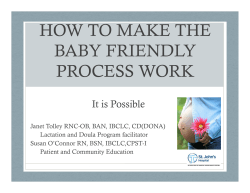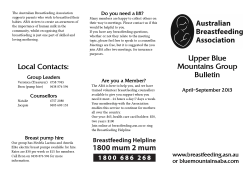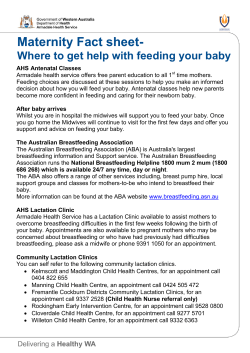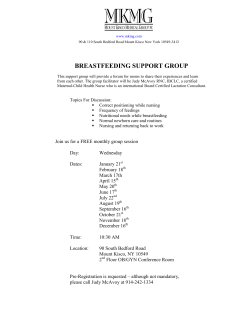
Supporting Breastfeeding Mothers as They Return to Work
Supporting Breastfeeding Mothers as They Return to Work By Marianne Neifert, MD, FAAP M What we know • year of age are employed. When their Research shows that breast milk, with its unique mixture of fatty acids, lactose, amino acids, vitamins, minerals, enzymes and other components necessary for digestion, brain development, and growth provides the ideal food for infants to both nourish them and to protect them from illness. maternity leave passes all too quickly, • others of young children are entering the workforce in unprecedented numbers, and most of these women endure lengthy, daily separations from their little ones. Today, whether by choice or necessity, the majority of mothers of infants under 1 many new mothers find themselves torn between genuine devotion to their baby and seemingly inextricable commitments in the world of work. The purpose of this article is to help pediatricians, health professionals, and child care providers Exclusive breastfeeding is ideal nutrition and sufficient to support optimal growth and development for approximately the first 6 months after birth. Gradual introduction of ironenriched solid foods in the second half of the first year should complement the breast milk diet. the home. We hope that this article will help • Continued breastfeeding is recommended throughout the baby’s first year, and thereafter as long as is mutually desired. Infants weaned before 12 months of age should not receive cow’s milk but should receive iron-fortified infant formula. mothers to continue breastfeeding as well • support mothers who have already decided to breastfeed and would like to continue to nurse their baby while working outside as raise breastfeeding levels to the recommendations proposed for inclusion in the Healthy People 2010 National Health Objectives (75% initiation of breastfeeding at birth, 50% continuation at about 6 months, and 25% still breastfeeding at 1 year). Companies are finding that it pays to help employed women reach their breastfeeding goals with fewer infant illnesses, less absenteeism, more satisfied and loyal employees, and lower retraining costs. • Mothers who continue to breastfeed after returning to work appreciate the maternal health benefits of nursing, feel more connected to their baby during the workday, as well as enjoy continued opportunities to nurse their baby when they are together. D E D I C AT E D TO T H E H E A LT H O F A L L C H I L D R E N How professionals can help Many women attempt to combine employment and breastfeeding, and some enjoy remarkable success. Others report frustration and disappointment due to lack of support, pumping facilities, time, energy, and eventually lack of milk. Pediatricians, health professionals, and child care providers can begin to support mothers simply by encouraging them to give breastfeeding a try and offering ongoing support as they transition back into the workplace. In consideration of the extensive published evidence for improved outcomes in breastfed infants and their mothers, a strong position on behalf of breastfeeding is justified. Mothers should be encouraged to think positively and not to assume that breastfeeding won’t be possible under their particular circumstances. Pediatricians and other health professionals can also • AAP RESOURCES The American Academy of Pediatrics (AAP) has several resources for health professionals on breastfeeding promotion including the AAP publications Breastfeeding Health Supervision and Checklists for Breastfeeding Health Supervision and the 1997 policy statement “Breastfeeding and the Use of Human Milk.” In addition, portions of Caring for Our Children: National Health and Safety Performance Standards: Guidelines for Out-of-home Child Care Programs , the AAP Pediatric Nutrition Handbook and the joint AAP/ American College of Obstetricians and Gynecologists manual Guidelines for Perinatal Care also contain relevant information. For more information, or to place an order, contact the AAP Direct Order Line at 888/227-1770. Also, the American Academy of Pediatrics has identified and trained pediatricians to serve as AAP chapter breastfeeding coordinators who support and promote breastfeeding activities in each state. Please call the AAP Division of Community Health Services at 847/981-7821 for contact information for the coordinator in your state. Opinions expressed are those of the authors and not necessarily those of the American Academy of Pediatrics. The recommendations in this newsletter do not indicate an exclusive course of treatment or serve as a standard of medical care. Variations, taking into account individual circumstances, may be appropriate. Any part of this newsletter may be reproduced for noncommercial educational purposes. © 2000 American Academy of Pediatrics Educate breastfeeding mothers and child care providers regarding breastfeeding and how to identify when an infant should be examined by a physician. • Become familiar with available publications and local breastfeeding resources including lactation educators and consultants, community breastfeeding support groups, and breast pump rental locations so that breastfeeding mothers can be referred appropriately. • Form a coalition with other community professionals (obstetricians and other physicians, state and local health department representatives, community health center and Special Supplemental Nutrition Program for Women, Infants, and Children [WIC] staff) so that the messages regarding breastfeeding promotion and management are consistent. • Encourage employers to provide appropriate facilities and adequate time in the workplace for breast pumping. Child care providers can also • Support mothers in their decision to continue breastfeeding, and talk about why breastfeeding is so good for babies. • Tell parents that they are happy to care for breastfed babies and are willing to feed them expressed breast milk. • Listen empathically and help mothers to articulate their breastfeeding goals. Working A Mother’s I n order to combine breastfeeding and working, it helps to have practical information, the support of your employer and coworkers, the cooperation of your child care provider, the encouragement of your partner, an effective breast pump and a place to use it, a cooler to store expressed milk, a sense of humor, an iron will, and a flexible baby. Successfully combining breastfeeding and working should actually begin long before the first day on a job. There are many things that you can do during your maternity leave that will improve the chances of continuing to breastfeed your baby after you return to work. The following recommendations may make the transition back to work easier for mothers who continue to breastfeed. Pediatricians and health care professionals may also find these tools useful as they support their patients during prenatal and well-child visits. • Provide a quiet place for mothers to nurse their babies. Focus on the Optimal Initiation of Breastfeeding • • Acquire as much information as possible before you deliver, including attending a prenatal class that covers the breastfeeding basics and gathering resources about pumping, storing, and feeding expressed breast milk. Educate themselves regarding the proper breast milk storage and serving methods. • Develop a plan in concert with the baby’s parents so that the baby can be fed on demand but, whenever possible, can be breastfed by the mother. • Include fathers and other supportive relatives or partners in decisions related to the baby’s care, and encourage them to feel good about the role they play in supporting continued breastfeeding of the baby. • Inquire whether your company offers any lactation support services for breastfeeding women. Without Weaning: Guide to Breastfeeding • Insist that your baby be examined by his or her pediatrician or primary care clinician within 48 hours of discharge and if you are having any problems, request to be referred to a breastfeeding specialist (ie, a physician or another licensed health professional with expertise in breastfeeding) for additional help. A community breastfeeding support group can also be helpful and answer many of your questions. These groups can be found on community bulletin boards (at the public library or park district) or in your local phone book. • If no formal corporate lactation program or facility is in place, request informal support for your breastfeeding plan. Discuss with your employer a plan for breastfeeding your baby and/or expressing your breast milk during the workday. Ask your employer to help you find a suitable location to pump and to authorize flexible use of your breaks for breastfeeding or expressing milk. • Let your employer know you appreciate his or her support and cooperation. • Use your hospital stay to optimize early breastfeeding experiences and prepare for breastfeeding at home. Ideally, you will be able to nurse your baby shortly after delivery, room-in with your infant, request assistance to help you position your baby correctly, feed your infant on demand, and avoid giving your baby a pacifier until breastfeeding is well established. • Ask your child’s pediatrician for information on breast milk storage and handling guidelines. Explore the Possibility of a Gradual Return to Work, if Employment and Personal Circumstances Permit • Request as much time as possible or ask for a range of time. In general, the longer, the better. Four months is better than 3 months. Ten weeks is better than 8 weeks. Six weeks is better than 4. • Don’t be afraid to ask for more time than you think will be granted or to explore part-time or job share possibilities. There may be opportunities that are not typically advertised that might be missed without asking. Begin Collecting and Freezing Excess Milk Before Returning to Work • Become familiar with pumping options as early as possible, and begin expressing milk while at home on maternity leave. This can begin as soon as your milk supply is established. • Use a hospital-grade electric breast pump whenever possible; one with a double collection system will allow you to drain both breasts at once and save you valuable time. There are also smaller electric models, battery-operated pumps, and manual pumps. It is also possible to learn how to empty your breasts with hand expression. • Remember that babies need to nurse until they are content and, if all is going well, will typically gain 4 to 7 ounces per week. (Please check with your baby’s pediatrician or primary care clinician to determine what type of weight gain is appropriate for your baby given his age, development, and size.) • Try to recognize when you are experiencing a milk surplus and take advantage of this. After feeding the baby, pump or express the residual milk. Begin after a morning feeding when your milk supply is generally greater. • Pumping and freezing any extra milk will allow you to take advantage of and maintain a milk surplus and will help to condition the milk ejection reflex to be triggered by pumping or hand expression. (Guidelines for refrigeration and freezing of expressed breast milk can be found in a variety of publications, including the AAP brochure, A Woman’s Guide to Breastfeeding.) • Allow at least 2 weeks to prepare for the time when you will be away from your baby. Express breast milk at least once each day, and save your breast milk for your child care provider to give your baby. Stockpile as much expressed milk as you can, at least enough milk to feed your baby the first day you return to work and to allow for the unexpected during the first few weeks (eg, spills, missed pumping time at work, or a sudden increase in baby’s consumption). Introduce Your Baby to Bottle Feeding • Introduce bottle feeding to your baby after breastfeeding is well established (at least 3 to 4 weeks). • Plan a time when you can devote 10 to15 uninterrupted minutes to this endeavor. Your baby will feel pressured if you are rushed. Choose a time when your baby is alert and slightly hungry, but not upset or frantic, so he will be motivated to learn a new way to receive milk. • Offer warm expressed breast milk in a clean bottle. Typically, it makes the most sense to stick with one type of nipple for several days to allow the baby time to accept it, although some babies prefer one nipple shape over another and you may need to experiment. • Try to be aware of and respond to your baby’s cues. Consider that some breastfed babies accept a bottle more readily when it is offered by someone other than their mother, while others actually accept the bottle better when they are in their own mother’s arms and can hear her voice. • Express a little milk from the artificial nipple onto the baby’s lips or tongue. Slowly and gently introduce the nipple bit by bit into the baby’s mouth, and let him explore it orally. Smile and offer words of reassurance in a calming tone. • Don’t spend more than about 10 minutes on this process, and stop sooner if the baby becomes frustrated. End the session on a positive note and try again tomorrow. Identify Quality Child Care Arrangements • Try to arrange child care at or near your workplace. Find someone you trust who is supportive of breastfeeding to care for your child. Look for a home or facility where your child will be physically safe, where her emotional and intellectual development will be optimized, and where she can have a close, nurturing, positive relationship with a single caregiver or a few consistent caregivers. • Ask whether your child’s caregiver has breastfed her own children or cared for breastfed babies, and determine if she is willing to cooperate with you in your attempts to continue breastfeeding. Discuss how she feels about handling your breast milk, coping with a baby who may not take a bottle readily, and waiting to give a bottle if you are due back shortly and could nurse upon arrival. • Arrange to leave your baby with the child care provider for several hours on one or more occasions before you actually start work. Ask her to feed your baby while you are gone. • Clarify what the child care provider should do if you are late picking up your baby. Show her how to hold your baby during feedings and how to quiet and comfort him when he is upset. Spend some time reviewing your baby’s eating, sleeping, elimination, and behavior patterns. • Discuss recommendations for the storage and handling of your expressed breast milk. Support for Breastfeeding and Working Never underestimate the importance of support from family, physicians, and child care providers for choosing to breastfeed your baby when you are employed. Support is one of the key factors that enable many women to make the choices that give them the outcome they desire. Talk to or form a support group with other working women who breastfeed. A community breastfeeding support group is another good source of support and management tips during this busy time. Remember to take care of yourself! Get plenty of rest, and eat nutritious food and non-caffeinated drinks to maintain your milk supply and your health. Your diet should be well balanced and include lots of fruits, vegetables, carbohydrates, and fluids. Also remember that some breast milk is better than no breast milk. No matter how long you are able to continue breastfeeding, congratulate yourself for your accomplishments and what you were able to do. Dr Neifert is a member of the American Academy of Pediatrics (AAP) Task Force on Breastfeeding and a nationally recognized speaker and author on breastfeeding and other family health topics. RESOURCE LIST The American Academy of Pediatrics (AAP) has several resources for women who want to continue breastfeeding after they return to work including A Women’s Guide to Breastfeeding, Child Care: The Best Choice for Your Family, Guide to Your Child’s Nutrition , and Caring for Your Baby and Young Child: Birth to Age Five . For more information, contact the AAP Department of Marketing and Publications at 888/227-1770. The AAP Division of Community Health Services (phone: 847/981-7821) can also provide you with copies of the Healthy Mothers, Healthy Babies brochure Working and Breastfeeding: Can You Do It? Yes You Can! TM Please contact Healthy Mothers Healthy Babies at 202/863-2458 for additional resources or information on local/state breastfeeding coalitions. Contact the International Lactation Consultant Association at 919/787-5181 for a list of certified lactation consultants in your area. Call La Leche League International at 800/LA LECHE or visit their Web site at www.lalecheleague.org for referral to a local community breastfeeding support group. This article was developed with the assistance of Laura Aird, MS, Director, AAP Division of Community Health Services. For more information about AAP breastfeeding and child care health and safety activities, please check the AAP Web site: www.aap.org. FURTHER READING Neifert, Marianne. Dr Mom’s Guide to Breastfeeding . New York, NY: Plume; 1998 Healthy Mothers, Healthy Babies Coalition of Washington State. Working & Breastfeeding… “It’s Worth It!” 1999 Photos courtesy of La Leche League International
© Copyright 2025









